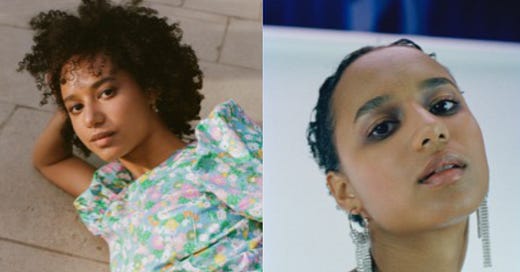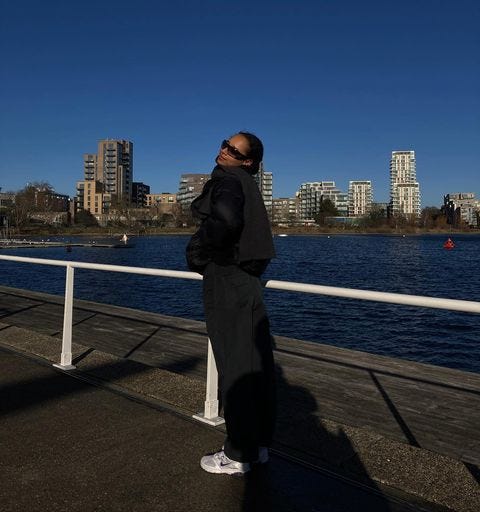Frankie Girling Talks About the Impact of Social Media on Modelling
Social media changed many aspects of our society, including the modelling industry. That's why we talk to an up-and-coming model from London about the benefits of these mediums.
Morning!
Great to have all of you here again. Today, I have a completely new format for you – well, it's not that special – but it's new for this newsletter. Grab yourself a coffee, pick a nice sunny spot and let us dive into the first interview on Garms & Yarns.
Quick note: In case you are currently not in the mood to read about entertainment, here is my recent article on the Ukraine crisis.
Earlier this week, I grabbed an after work drink with Frankie Girling and we chatted about the impact of social media on the modelling industry. Because Instagram, Tiktok, and Co. have distinctly shaped this sector.
Anyway, I don't want to be rude, so firstly I'll introduce you to today's guest. Frankie Girling is a model and fashion design student in London. Recently, she gained a lot of attention with her social media performance: The East London-local has managed to gain more than 2300 followers within the last 30 days and over 10'000 followers since last September. Characterised by her short reels, showcasing her active lifestyle on her bike or in nature, she maintains an active but natural approach to her social media profile.
How Social Media Has Impacted The Modeling Industry
In recent times, the criteria for being defined as a «model» or «supermodel» has been redefined because now, it is crucial that all those in the industry have a significant digital presence.
Instead of only asking about height and hair colour, a casting directors' first question is nowadays «How many followers does she have?». While this may come as a shock, it is no longer enough to be beautiful, fit and healthy, because models now have to be social media influencers as well. They need to have tons of followers and relatively high engagement rates to pursue a glamorous career.
Managing Director of Vivien's Models, Catherine McGill, explains that most companies today won't even consider a model unless they have at least 10,000 followers on social media. In response, agencies such as Chic and Vivien's Models have adapted to these client demands by setting up influencer departments. The reasons for this are obvious: a client would not be able to have such a diverse and organic reach with a magazine, because not nearly as many people read magazines as they do engage with social media.
Therefore, aspiring models have had to incorporate self-promotion into their repertoire in order to stay relevant in the fashion world. If their follower base is large enough, they are called influencers, which sets them apart from models without that digital reach. Today's models need to master social media to solidify their brand. Yet, this also brings opportunities for models who don't have the classic look.
But, let’s listen to Frankie how she’s dealing with social media and modelling:
So Frankie, tell us: How did your huge growth on Instagram start?
Honestly, it was quite random. I love cycling and I tend to ride around East Central London when I'm stressed – this was also the case on this day. I liked my outfit and hair I went out with, so I decided to record a short video.
So quite spontaneously?
Totally! I was just wondering around and spotted this building that looked like the set of Fight Club. Then I stopped for a couple of minutes and took the video.
That's your approach?
Not to sound cliché. But I had to learn just to be a bit more myself on social media, and not compare myself too much to others. Now, I show my everyday life: mostly on the go with pretty comfortable fits – because I’m riding my bike.
Well, it seems to work, the reactions are incredible.
Definitely. Interacting with my growing community is amazing and especially all the positive messages about my hair is pretty heartwarming.
Speaking of hair: What is it like modelling with a unique hairstyle like yours?
Actually, really nice. Some stylists have not had a lot experience with hair textures like mine, but that's okay. At the moment, I feel like models with a unique look are getting more and more attention which is great.
Because of social media?
I think so. To me, it seems like we’re seeing more and more natural bodies and unedited faces on social media. Brands and casting directors are seeing this too, and indirectly it is leading to a more diverse modelling industry.
What is your take on agencies, like Chic and Viviens's Models, that only sign models with a strong social media following?
Obviously, it adds another element to the professional profile. But non-classic looking models can prove themselves through their following.
In which sense?
For example, a plus-size, short or petite model with a large community can show that there is interest in their appearance. It gives the models a certain power and self-confidence and proves that the audience wants to see a wide range of models.
Has your growth also already changed your bookings?
Not that much so far. I've already been with my agency for two years and the growth is so recent – only a month or two old! I think it will take a few more months before I notice the first difference.
Lastly, once you reach the point you can pick your jobs, what brand do you go for?
Well, if that was the case, I'd love to work for Paloma Wool one day.
Sunny Side of Social Media
In conclusion, we can state that social media, among other things, also bring a positive aspect to the otherwise controversial modelling industry. Personally, I am convinced that this development will carry on and contribute more diversity to the editorials and catwalks of our fashion world.
In the meantime, have a great day.
Love,
Pascal






